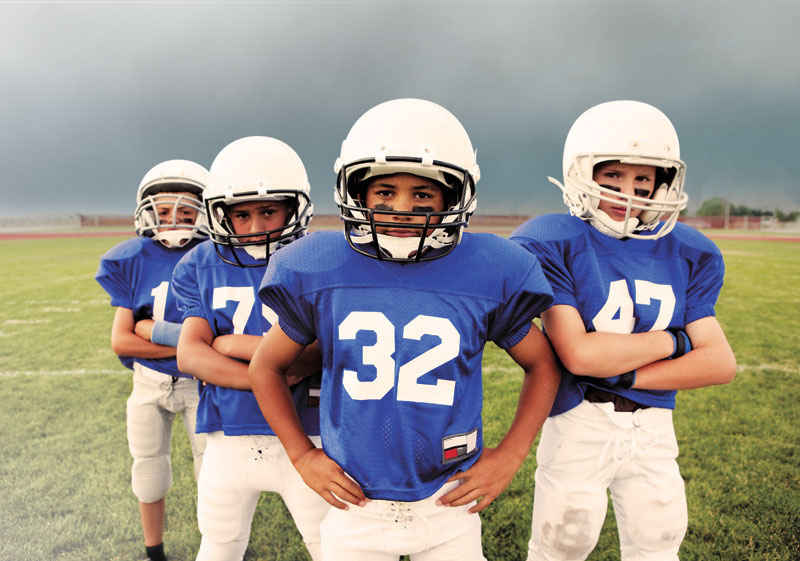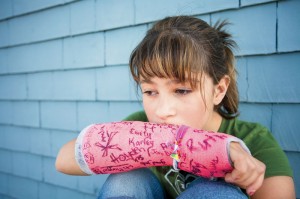Youth Sports Burnout — The push for perfection
By Mark Zonca
August 2012 View more Featured

On any given weekend in Naperville, a drive around town quickly reveals the enormous popularity of competitive youth sports. Nearly every green space in Naperville seems to be occupied by weekend warriors and their sometimes over zealous fans. From little league baseball and soccer, to football and lacrosse. However, are parents pushing young players too hard and at too young of an age to gain the competitive edge? Are young athletes being pushed to perfection?
Not just child’s play
Recent studies have shown that more than 30-45 million children are involved in competitive youth sports and that number is expected to grow in the years ahead. More children are beginning to play competitive sports at an earlier age and specializing in one sport before they even reach high school. For many young athletes, and their parents, it’s more than just about winning and losing—it’s about securing that starting position on the high school roster and ultimately earning a college scholarship.
“We have over 200 athletes that are currently in college playing sports. Last year, we helped more than 30 athletes receive Division 1 scholarships from this area,” said J.R. Niklos, director of sports performance at Acceleration Naperville.
More parents and their young athletes, some as young as 8 years old, are turning to personal trainers, like J.R. Niklos, to give them the competitive edge in competitive sports. Niklos played in the NFL with the Seattle Seahawks, St. Louis Rams, Oakland Raiders, Kansas City Chiefs and the Cleveland Browns.
“It’s so competitive now. Recruiting is so important—even at an early level. If you don’t decide (what sport to play) by your freshman or sophomore year in high school, you won’t make it playing in college,” said Niklos.
Personalized Training
Many parents seem willing to shell out top dollar in the hopes of developing laser-sharp athletic performance. At Acceleration Naperville, and at a growing number of athletic performance clinics, trainers work with young athletes to become faster, quicker, stronger, and gain the skills to compete at a higher level. Trainers focus on developing core skills, such as speed, agility, power, weight and vision.
The personalized training programs offered at Acceleration focus on more than just sport specific skills.
“We want our athlete to master the basics of good health. Nutrition is key. Recovery is key. Making progress in exercising is also important,” said Niklos.
More training, more injuries
More training does not necessarily equal better results. In fact, some experts say it may actually have the opposite affect. With more frequent and intense training, many young athletes are being sidelined by injuries for longer periods of time.
In a recent report from The American Academy of Pediatrics, 50% of all injuries seen in pediatric sports medicine are related to overuse.
“This can be caused by a lack of days off, too many repetitions during practice, too many games, or a combination of those,” said Nathan Sels, manager and physical therapist, Athletico Physcial Therapy in Naperville.
With young athletes, you can categorize the injuries into two main categories: traumatic and overuse.
“This can impact all areas in the body and the concern is in the youngest populations when the growth plates are still open and they are still skeletally immature,” said Sels.
“In regards to athletes in baseball, softball, volleyball, and swimming, you look for shoulder and elbow injuries. In regards to soccer, you are concerned with ankle, knee, and hip injuries,” said Sels. “Spinal injuries can occur in any sport with lack of ‘core’ stability.”
Athletes need to train smarter, not harder. Experts say it’s better to under train than to over train.
“More is not necessarily better. Athletes younger than 10, should only train twice per week. High school athletes can train up to three times per week. We are actually seeing better results with training three times per week rather than four times per week,” said Niklos.
Hitting the wall
Overuse and overtraining can lead to physical and mental burnout. However, not every athlete will hit the wall the same way. Some athletes, even at the youngest ages, have the ability to train at extraordinary levels without breaking down. For others, there are important warning signs of burnout.
“Warning signs for parents and coaches should be increasing amounts of fatigue, elevated or complaints of pain after sports that impacts the completion of basic daily life, worsening levels of play, and loss of athleticism. This requires a maturity from the athlete to discuss these if they are occurring, as well as a keen eye from coaches and parents to head these off before they get out of control,” said Sels.
“If you look at our professional athletes they all have an off-season where they recover, rest, and then retrain. Why we do not do the same to our kids baffles me at times,” said Sels.
A winning combination
The chances of your son or daughter playing college or professional level sports are better than winning the lottery—but not by much. Depending on the sport, less than 1/2% of high school athletes ever make it to the pros, according to an American Academy of Pediatrics report. That means too many teens and pre-teens are exposing themselves to injury and burnout for little to no pay-off. The report also details that kids who play multiple sports, and take reasonable breaks for training and competition throughout the year, are more likely to enjoy sports longer.
“I believe the balance is in participation in multiple sports. If we look to the top athletes in the world playing professionally they were in multiple sports. Each sport has a different skill set and requirement on the body and participation in more than one helps the overall athletic development,” said Sels.
Keys to athletic success
- Don’t specialize in one sport too early
- Cross training and participation in multiple sports is critical to full athletic development
- Allow your body to recover and rest during the off-season
- Proper nutrition and sleep
The benefits of organized sports
While the dream of playing professionally motivates many young players, parents should be clear that the goal of youth sports is about building healthier kids and not necessarily about building athletic careers.
Aside from the obvious health benefits, there are also important life lessons to be learned from the playing field:
- Respecting others (including opponents)
- Exercising self-discipline
- Playing fairly
- Being a good winner and loser
- Developing teamwork and trust
- Overcoming challenges and frustrations
- Learning to deal with constructive criticism
- Responding positively to disappointments
- Taking responsibility for mistakes
- Showing leadership
- Making friends
- Learning to resolve conflicts
- Learning to deal with stress
- Setting goals
- Following rules
These life lessons benefit kids in whatever path they set in life. They provide parents with strong incentives to motivate their kids to play longer, whether or not these efforts land their kids college scholarships or professional contracts.
Preventing Burnout*
- Keep workouts interesting with age-appropriate games and training
- Take one to two days off per week to allow the body to rest
- Permit longer scheduled breaks from training and competition every two to three months to focus on cross training
- Listen to your body for signs to slow down
Stages of overuse injuries*
- Pain in the affected area after physical activity
- Pain during the activity without restricting performance
- Pain during the activity that restricts performance
- Chronic pain even at rest
* Source: American Academy of Pediatrics



